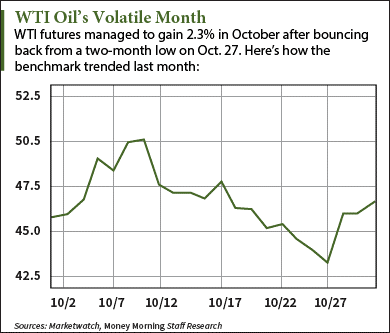 WTI crude oil prices today (Tuesday) jumped 1.6% as production issues persist in Libya and Brazil.
WTI crude oil prices today (Tuesday) jumped 1.6% as production issues persist in Libya and Brazil.
At 10 a.m., WTI crude oil prices traded at $46.89 a barrel. The U.S. benchmark leaped 2.3% in October despite hitting a two-month low of $43.20 on Oct. 27. Prices are now down 21.1% in 2015.
Brent crude oil prices saw the same gains this morning. The global benchmark ticked up 1.6% to $49.55 a barrel. Futures gained 1% in October and are down 24.3% so far this year.
The rise in WTI crude oil prices today came on news of production problems in major Libyan and Brazilian oil regions.
This morning, Bloomberg reported Libya indefinitely halted crude oil shipments from its major Zueitina port amid conflict between the country's rival administrations. The ongoing unrest limited Libya's daily production capacity to 432,000 barrels a day in October. That's far below the 1.5 million barrel average.
Additionally, Brazil's largest oil sector union - Oil Workers Federation - began a strike on Sunday against Petrobras SA (NYSE ADR: PBR). The union is protesting the company's plans to cut more than $15 billion in costs by laying off thousands of workers. The limited workforce at Brazil's largest oil corporation has temporarily caused a nationwide supply shortage.
Despite shortages overseas, investors worry the growing U.S. supply glut will send prices lower over the long term. According to the U.S. Energy Information Administration (EIA), U.S. inventories increased by 3.4 million barrels during the week ended Oct. 23. That puts total U.S. supply at an 80-year high of 480 million barrels.
But Money Morning Global Energy Strategist Dr. Kent Moors says you can make money in the energy sector no matter where oil prices move.
All you need to do is follow these three tips for picking the most profitable oil stocks...
Three Ways to Profit from WTI Crude Oil Prices
Here are three methods for finding the best oil stocks to buy in today's unpredictable price environment...
- Use the "Yardstick": The yardstick is a tool that examines the relationship between a company's known oil reserves and its trading price. This is important for investors because there's usually a correlation between a company's profit potential and the amount of oil it has access to - but has not yet extracted. The yardstick helps you identify undervalued stocks with the best near-term appreciation potential based on how much oil a company owns. Start banking profits by learning more about this easy-to-use tool here...
- Identify "Traditional" Drillers: The cost of production can make or break an oil company during low price periods. Firms pursuing expensive onshore projects involving unconventional, horizontally drilled wells become unprofitable when prices aren't near $100 a barrel. That's because higher production volumes don't offset higher operating costs when prices are near their current $50 levels. You want to invest in companies drilling this type of "traditional" well to remain profitable no matter how low prices go...
- Look for Mergers and Acquisitions: The oil pricecrash over the last 18 months has bankrupted a number of companies. One such firm is Hercules Offshore Inc. (OTCMKTS: HEROQ), the Houston-based drilling company that went belly up in August. The low price environment has primed the oil sector for a wave of M&A activity, resulting in a new group of heavyweight companies that will lead the market into what Moors calls the "new energy age." Here's how you can identify those companies poised to benefit from restructuring...
[mmpazkzone name="in-story" network="9794" site="307044" id="137008" type="4"]
Alex McGuire is an associate editor for Money Morning who writes about commodities. Follow him on Twitter for all of the biggest oil and gas updates.
Related Articles:


